F
FCC/AOS An American Orchid Society flower award denoting a First Class Certificate, awarded to an orchid species or hybrid that scores 90 points or more out of a possible 100 points.
Falcate: Cattleya granulosa has falcate lateral sepals.
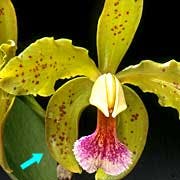
falcate (FAL-kayt) Scythe-shaped; curved and flat, tapering gradually.
family (FAM-uh-lee) The usual major subdivision of an order or suborder, commonly comprising a plurality of related genera; ending with -aceae as in Orchidaceae.
fallax (FAL-laks) Deceptive; false; fallacious.
fan and pad A greenhouse cooling system that consists of a moistened high surface area pad on one wall in conjunction with exhaust fans on an opposing wall, the air being cooled by evaporation.
farinaceus, -a, -um (fa-ri-NAY-see-us) Containing starch, or starch-like materials; mealy, like flour; farinaceous.
farinosus, -a, -um (fa-ri-NOH-sus) Covered with meal-like powder; mealy; powdery; farinose.
fasciation (fa-see-AY-shun) A malformation caused by an abnormal growing point, the expanded mass often called a crested, the plant a "crested" form.
fasciatus, -a, -um (fa-see-AY-tus) Bound together; clustered or grouped into bundles; fasciated.
fascicle (FAS-i-kul) A close cluster or bundle of flowers, leaves, stems or roots.
fascicularis, -e (fa-sik-yew-LAIR-is) In close bundles or clusters.
fascinator (fa-si-NAY-tor) Unusually attractive; fascinating.
fastigiatus, -a, -um (fa-sti-jee-AY-tus) Having branches close together and erect, often forming a column; fastigiate.
faveolate (fah-VEE-oh-layt) Honey-combed.
fecundation (fee-kun-DAY-shun) Fertilization of the female by the male to form a new individual; impregnation.
feminine (fem-in-in) Pistillate (in higher plants); possessing the female sex apparatus.
fenestralis, -e (fen-neh-STRAY-lis) Pierced or furnished with window-like openings; fenestrate.
fermate (FER-mayt) An organic fungicide, ferric dimethyl dithiocarbonate, useful as a spray or dust to combat leaf spot, stem rot, root rot and similar infectious diseases.
Fernandezia (fur-nan-DEEZ-ee-ah) A genus of about 10 species of Andean, montane, pseudo-monopodial orchids known for their striking red-orange flowers.
ferrugineus, -a, -um (fer-roo-JIN-ee-us) Rust-colored; rusty; ferrugineous.
fertilis, -e (FER-till-is) Capable of producing numerous seeds or viable pollen; fruitful; fertile.
fertilization (fer-till-eye-ZAY-shun) (1) The fusion of two gametes to form a new individual (zygote); the effect of pollination, resulting in the conversion of the flower into fruit and of the ovules into seed. (2) The application of nutrients to the growing medium.
fertilizer (fer-till-EYE-zer) A substance, organic or inorganic, that provides nutritional elements necessary to plant growth; a plant food.
ferus, -a, -um (FER-us) Wild.
festivus, -a, -um (FES-ti-vus) Beautiful; gay; bright; festive.
fetidus, -a, -um (FET-i-dus) Having a disagreeable odor; fetid. (See also foetid)
fibrillosus, -a, -um (fib-ri-LOH-sus) Composed of fine fibers or threads; fibrous; fibrillose.
fibrosus, -a, -um (fye-BROH-sus) Composed of or resembling fibers; the texture of roots as in Listera; fibrous.
filament (fill-ah-ment) The threadlike support of the anther; threadlike.
filiformis, -e (fil-i-FOR-mis) Long, slender and flexible.
Fimbriatum: Catasetum fimbriatum, named for its fringed lip.
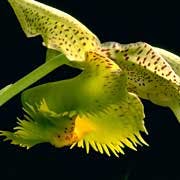
fimbriatus, -a, -um (fim-bree-AY-tus) Fringed; fimbriate.
fimbrillate (FIM-bril-layt) Minutely fringed; fimbrillose.
Finet, Achille (1862–1913) A French botanist who worked on the orchids of China and Japan and contributed substantially to our knowledge of angraecoid orchids. He is commemorated in the genus Neofinetia.
fir bark A potting medium consisting of the chopped or ground bark of white fir, red fir or Douglas fir.
fissile (fiss-eye-l) Splitting.
fistularis, -e (fist-yew-LAIR-is) Cylindrical and hollow; fistulous.
Fitch, Walter Hood (1817–1892) Outstanding botanical artist who was sole illustrator for Curtis' Botanical Magazine from 1834–1877. His admirable lithographs of orchids have appeared in Hooker's A Century of Orchidaceous Plants (1854), Bateman's Second Century of Orchidaceous Plants (1867), Bateman's Monograph of Odontoglossum (1864–1874) and Warner's Select Orchidaceous Plants (1862–1891).
Fitch, John Nugent (1840–1927) Nephew of Walter Hood Fitch, he continued his uncle's work after his death, lithographing plates for Curtis' Botanical Magazine in a similar manner. He produced all the original drawings for The Orchid Album (1882–1897).
Fitzgerald, Robert D. (1830–1892) Deputy Surveyor-General of New South Wales, Australia, he was a keen amateur botanist who wrote and illustrated the monumental publication Australian Orchids, (1875–1888), the first comprehensive treatment of the native orchids of Australia.
Flabellata: Aerides flabellata, has a fan-shaped lip.
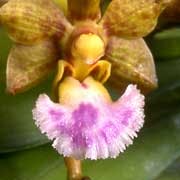
flabellatus, -a, -um (fla-bel-LAY-tus) Fan-shaped; flabellate; flabelliform.
flaccidus, -a, -um (FLAS-si-dus) Weak, drooping, usually applied to flower stems; soft, lax, not rigid.
flagelliformis, -e (fla-jell-i-FOR-mis) Whip-form; long and slender like a lash; flagelliform.
flask (1) Any clear container used in the germination of orchid seed and other forms of micropropagation; (2) To sow orchid seed or to transplant seedlings into such a container.
flasking The process of sowing orchid seed or transplanting seedlings or other tissue into a flask.
flat Shallow tray or box, usually of plastic, in which small seedlings are grown in quantity.
flavescens (fla-VEH-senz) Yellowish; turning yellow; flavescent.
flavidus, -a, -um (FLAY-vi-dus) Yellow; flavid.
Flava: Cattleya flava, has yellow flowers.
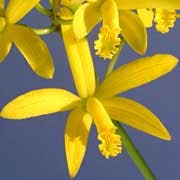
flavus, -a, -um (FLAY-vus) Yellow; flavid.
flexuosus, -a, -um (flek-shoo-OH-sus) Bending alternately in opposite directions.
Flickingeria (flik-in-GEER-ee-ah) A widespread Asiatic genus with 75 species characterized by ephemeral flowers, formerly known as Ephemerantha, and now included in the revised genus Dendrobium.
floccose (FLOK-ohs) Having tufts of wooly hair.
flora The plant composition of a given region; also a book describing this composition.
floralis, -e (floor-RAY-liss) Of or pertaining to the flower; floral.
floriculture The art and science of growing flowers.
floridus, -a, -um (FLOOR-i-dus) Literally flowering and thence flourishing; bright, florid.
floriferous Flower-bearing; blooming freely.
florula (floor-UHL-ah) Literally a small flora, referring to a flora of a relatively small area such as a nature preserve.
foetid (FEE-tid) With a disagreeable odor; fetid.
foliaceus, -a, -um (foh-lee-AY-see-us) Resembling a leaf in texture and appearance; bearing leaves; foliaceous.
foliaceous bract (foh-lee-AYE-shuss brackt) A bract that is broad, green and leaf-like, the leaf-like structure subtending the pseudobulb in genera such as Brassia and Miltonia.
foliage (foll-ee-ayg) Leaves.
-foliate (foll-ee-ayt) In combinations, -leaved; having leaves; as trifoliate, "three-leaved."
foliosus, -a, -um (foh-lee-OH-sus) Leafy; foliose.
-foliolate (FOH-lee-o-layt) Having leaflets; as trifoliolate; "of three leaflets."
foot (of column) An extension of the base of the column beyond its point of attachment to the pedicel, or flower stem.
foot-candle A unit of illumination equivalent to that produced by a standard candle at the distance of one foot.
foramen (foh-RAY-men) An aperture or opening.
forcing (fore-sing) To hasten flower production by artificial means.
forked Branching or divided into nearly equal parts or members.
form A taxonomic designation referring to randomly occurring infrequent variants such as albinos.
formosanus, -a, -um (for-mo-SAY-nus) From the island of Formosa.
Formosum: Dendrobium formosum has beautiful flowers.
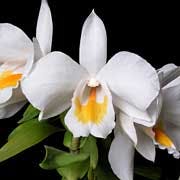
formosus, -a, -um (for-MOH-sus) Very beautiful in shape; therefore, strikingly ornamental.
formula (fore-MEW-luh) (in hybrids) The names of the two parents connected by the multiplication sign; the seed parent listed first, then the pollen donor.
fornicatus, -a, -um (for-ni-KAY-tus) Arched; fornicate.
Fowlie, Jack (1929—1993) Taxonomist and editor of the Orchid Digest (1967—1993)
fractiflex (FRAK-ti-fleks) Zig-zag.
fragrans (FRAY-granz) Sweet-scented.
free Not joined to other organs; as petals free from the stamens, calyx or themselves.
fringed (FRINJD) Furnished with hair-like appendages on the margins.
frond (FRAHND) Leaf of fern; sometimes used in the sense of foliage.
fructification (fruk-ti-fi-KAY-shun) The act or process of fruiting; also the fruiting organ or organs.
fruit (frewt) The seed-bearing organ of a plant.
fruticosus, -a, -um (froo-ti-KOH-sus) Shrubby or shrub-like in the sense of being woody; fruiticose.
fugacious (few-GAY-shus) Falling away or fading very early; transitory.
fulvus, -a, -um (FULL-vus) Tawny; fulvous.
fungicide (FUN-gi-syde) The class of chemicals that are used to destroy fungi.
furcatus, -a, -um (fer-KAY-tus) Forked or two-horned; furcate.
furfuraceus, -a, -um (fer-fer-AY-see-us) Scurfy; scaly, furfuraceous.
furrowed (fur-ROW-d) With longitudinal channels or grooves.
fuscatus, -a, -um (fus-KAY-tus) Brownish; dark; dusky; fuscous.
fusiformis, -e (few-si-FOR-mis) Spindle-shaped; narrowed both ways from a swollen middle; fusiform.








